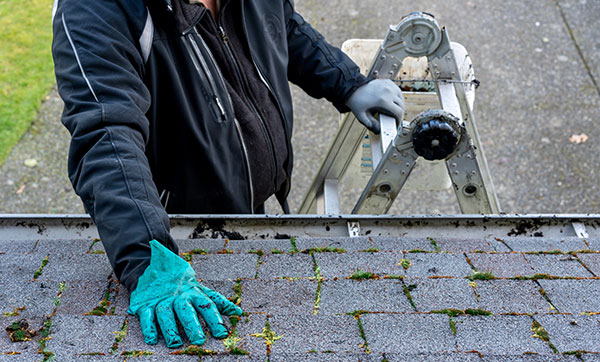How to Clean Roof Shingles
Author: Dan Stout | April 27, 2023
A discolored or debris-filled roof certainly looks better after a cleaning, but that's not the only benefit.

Black streaks on an asphalt or slate roof are signs of gloeocapsa magma, a bacteria that feeds on limestone and weakens asphalt shingles. And debris and moss growth can allow water to creep behind shingles, causing them to raise, which in turn creates space for more debris and moss to collect. This can have an effect like that of an ice dam, leading to leaks and interior damage.
If you're hoping to learn how to clean roof shingles, we've got you covered.
1. Safety
Always give careful consideration to your safety equipment. For most homeowners, this will mean securing a ladder on stable ground and wearing shoes suitable for roof walking. Depending on your roof's slope, you may need fall restraints. Safety glasses are a must: It's never pleasant to catch cleaning solution in your eye, and impaired vision on a roof could lead to a dangerous fall.
2. Cleaning Equipment
The exact equipment you'll need will vary by roof and shingle type. Most homes in the US have asphalt shingles, but yours may be slate, clay tiles, cedar or concrete. Additionally, flat and metal roofs have their own cleaning materials and best practices, not included in this article.
For most roofs, you'll need:
- A cleaning agent.
- A sprayer.
- A deck broom.
- Optional: a garden hose and a hand brush.
Resist the urge to use a pressure washer! High pressure is generally not suitable for cleaning roof shingles, with one notable exception: Concrete tile manufacturers such as Eagle Roofing recommend a pressure-wash for their product, usually capped at a prescribed PSI.
3. Cleaning Agents
There are two types of commonly used agents for cleaning roof shingles: home-brewed mixtures and commercial products. Home-brews are normally mixes of laundry-strength bleach and water, while commercial blends are proprietary.
Home Brews
The exact bleach-to-water ratio depends on your roof material and the stubbornness of the stains. For asphalt shingles, start with a 1:1 bleach-to-water ratio and increase as needed. Cedar shingles should start with a lower 1:3 ratio, moving to a 1:2 ratio if necessary. Home-brewed bleach solutions cab damage plants, so take all precautions described below. They are applied with a hand sprayer, and you'll rinse the roof after you clean it.
Commercial Cleaners
These come pre-mixed in containers often designed to be connected to a garden hose for application. Check the label to verify that it's safe to use on your roof. Commercial cleaners tend to be more plant-friendly, and there are some described as "wet it and forget it," which don't require rinsing.
4. Protect Surrounding Landscaping
Walk the area and look for plants that could be damaged by cleaner spillover. Don't forget to check the downspouts' runoffs as they'll have an extra high saturation of cleaning liquid. Spray plants with water before and after the cleaning process to protect them.
5. Sweep Away Debris
Begin by sweeping away any debris with the deck broom. This is also a good time to do a general roof inspection. If your roof shows curling or loose tiles, or a high amount of granules in the gutters, then it's probably time to consider a repair or replacement.
6. Mix the Cleaning Agent
Mix the cleaning agent to your custom ratio and fill a handheld sprayer or connect a commercial dispenser to a garden hose. Either method is fine, though if you're using a garden hose, be sure you have enough slack to safely traverse the work area and that it won't catch on the house or your lawn decorations as you're cleaning.
7. Spray
Begin about three feet from the gutters. Spray cleaner toward the gutter, never up into the shingles. Use the deck broom on stubborn stains. Work your way across the roofline, then up toward the ridge, being careful to stay on dry roofing as you go.
If you used a home-brew solution, you'll need to rinse the roof when you're done. If you used a commercial pre-mix, check the manufacturer's instructions — many products allow you to spray and walk away.
8. Reapply if Necessary
It may take a couple of passes to clean your roof completely. Home-brew mixtures should lighten black streaks within 10 – 15 minutes. Commercial mixtures designed to stay on the roof will show improvement as the algae or moss comes off in the ensuing days and weeks.
A good clean usually lasts about three to five years, but recognize when it's time to repair or replace your roof by visiting our guide for new homeowners eBook.